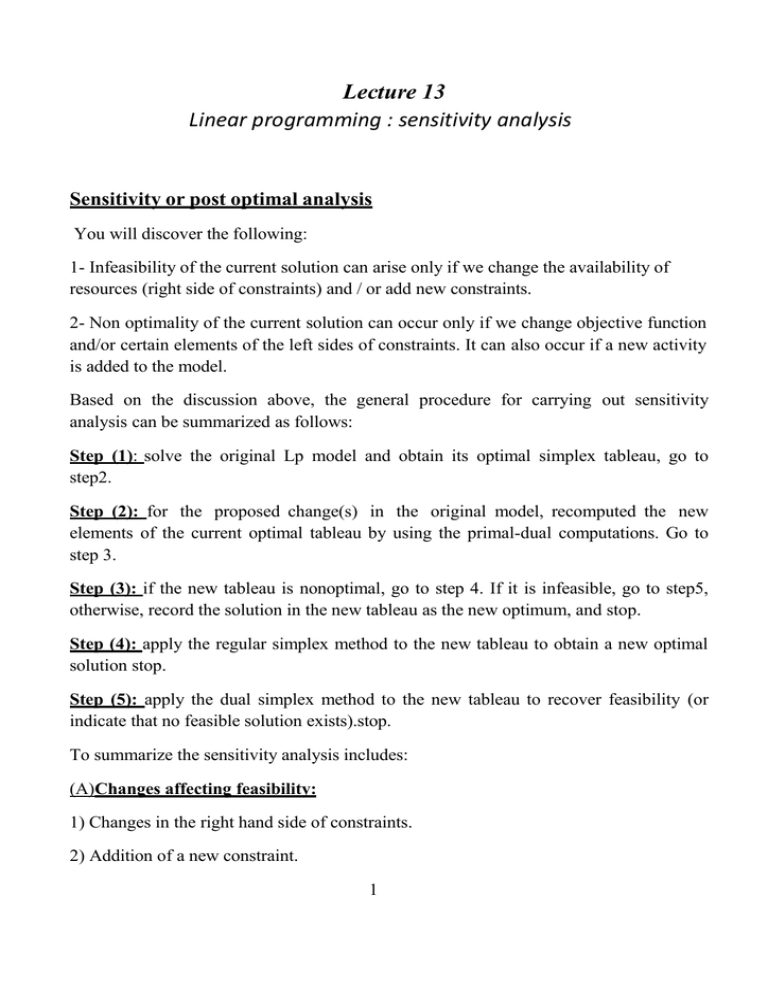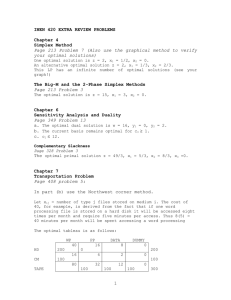Lecture 13 Sensitivity or post optimal analysis
advertisement

Lecture 13 Linear programming : sensitivity analysis Sensitivity or post optimal analysis You will discover the following: 1- Infeasibility of the current solution can arise only if we change the availability of resources (right side of constraints) and / or add new constraints. 2- Non optimality of the current solution can occur only if we change objective function and/or certain elements of the left sides of constraints. It can also occur if a new activity is added to the model. Based on the discussion above, the general procedure for carrying out sensitivity analysis can be summarized as follows: Step (1): solve the original Lp model and obtain its optimal simplex tableau, go to step2. Step (2): for the proposed change(s) in the original model, recomputed the new elements of the current optimal tableau by using the primal-dual computations. Go to step 3. Step (3): if the new tableau is nonoptimal, go to step 4. If it is infeasible, go to step5, otherwise, record the solution in the new tableau as the new optimum, and stop. Step (4): apply the regular simplex method to the new tableau to obtain a new optimal solution stop. Step (5): apply the dual simplex method to the new tableau to recover feasibility (or indicate that no feasible solution exists).stop. To summarize the sensitivity analysis includes: (A)Changes affecting feasibility: 1) Changes in the right hand side of constraints. 2) Addition of a new constraint. 1 (B)Changes affecting optimality: 1) Change in the objective function. 2) Change in the activities of resources. 3) Addition a new activity. (A)Changes affecting feasibility: (1) Changes in the Right side of constraints (bi). Example (1):- let the following L.p.p: Max Z=3x1+2x2 x1+2x26 s.t 2x1+x28 -x1+x21 x22 x1,x2 0 And the primal optimal tableau is: B.V Z X2 X1 S3 S4 X1 0 0 1 0 0 X2 0 1 0 0 0 S1 1/3 2/3 -1/3 -1 -2/3 S2 4/3 -1/3 2/3 1 1/3 S3 0 0 0 1 0 S4 0 0 0 0 1 R.H.S 38/3 4/3 10/3 3 2/3 If we change the right hand side of the first constraint from (6) to (7).How the current solution affected? 2 Solution: x2 2/3 -1/3 0 0 7 -1/3 2/3 0 0 8 s3 -1 1 1 0 1 2 s4 -2/3 1/3 0 1 2 0 x1 = 2 = 3 Since the new right-side elements remain nonnegative, the current basic variables remain unchanged. Only their new values become: x1=3 , x2=2 the new values of Z=3(3) +2(2) =13. Let us now consider an example of what happens when the current basic variables becomes infeasible, suppose that the right side changed from follows : 6 8 to 1 2 x2 7 4 , then the right side of the tableau is computed as 1 2 2/3 -1/3 0 0 7 -1/3 2/3 0 0 4 s3 -1 1 1 0 1 -2 s4 -2/3 1/3 0 1 2 -4/3 x1 = 10/3 = 1/3 Now we use simplex tableau since there are negative values in the right side B.V Z X2 X1 S3 S4 X1 0 0 1 0 0 X2 0 1 0 0 0 S1 1/3 2/3 -1/3 (-1) -2/3 3 S2 4/3 -1/3 2/3 1 1/3 S3 0 0 0 1 0 S4 0 0 0 0 1 RHS 23/3 10/3 1/3 -2 -4/3 The solution in the above table is optimal since (Z-Cj>=0) but infeasible (at least one basic variable is negative. Thus we must use dual simple method to recover feasibility, the application of the dual simplex method shows that the leaving and entering variables are S3 and S1 .this leads to the following tableau: B.V Z X2 X1 S1 S4 X1 0 0 1 0 0 X2 0 1 0 0 0 S1 0 0 0 1 0 S2 5/3 1/3 1/3 -1 -1/3 S3 1/3 2/3 -1/3 -1 -2/3 S4 0 0 0 0 1 R.H.S 7 2 1 2 0 The above tableau is both optimal and feasible. The new solution is: x1 =1 , x2 =2 , Z=7 (2) Addition of a new Constraint. The addition of a new constraint can result in one of two conditions: 1-The constraint is satisfied by the current solution, in which case the constraint is either nonbinding or redundant and its addition will thus not change the solution. 2-The constraint is not satisfied by the current solution. It will thus become binding and a new solution is obtained by using the dual simplex method Example (2): If we add a new constraint x1 4 to the model problem in example (1). Since the current solution (x1 =10/3, x2 =4/3) obviously satisfies the new constraint, it is lableau nonbinding and the current solution remains unchanged. Now suppose that the new constraint is x1 3 add in the problem in example (1), which is not satisfied by the current solution x1 =10/3 , and x2 =4/3 . Here is what we do to recover feasibility. First, put the new constraint in the standard form by adding a slack variable or surplus variable if necessary. Using S5 as a slack, we find that the standard form of x1 3 is x1 + S5=3, S5 0,and add to the optimal table : 4 X1 X2 S1 S2 S3 S4 B.V 0 0 1/3 4/3 0 0 Z X2 0 1 2/3 -1/3 0 0 X1 1 0 -1/3 2/3 0 0 S3 0 0 -1 1 1 0 S4 0 0 -2/3 1/3 0 1 S5 1 0 0 0 0 0 In the x1- equation of the current optimal tableau, we have: S5 0 0 0 0 0 1 R.H.S 38/3 4/3 10/3 3 2/3 3 x1–(1/3)S1 +(2/3)S2=10/3 Thus the new constraint expressed in terms of the current non basic variables becomes: (10/3)+ (1/3) S1–(2/3)S2=3-S5 (10/3)+ (1/3)S1–(2/3)S2+ S5=3 (1/3)S1–(2/3)S2+S5 =(-1/3) We add this equation in the optimal tableau B.V Z X2 X1 S3 S4 S5 X1 0 0 1 0 0 0 X2 0 1 0 0 0 0 S1 1/3 2/3 -1/3 -1 -2/3 1/3 S2 4/3 -1/3 2/3 1 1/3 -2/3 S3 0 0 0 1 0 0 S4 0 0 0 0 1 0 S5 0 0 0 0 0 1 R.H.S 38/3 4/3 10/3 3 2/3 -1/3 S5 2 -1/2 1 3/2 1/2 -3/2 R.H.S 12 3/2 3 5/2 1/2 1/2 By using dual simplex method the optimal tableau is: B.V Z X2 X1 S3 S4 S2 X1 0 0 1 0 0 0 X2 0 1 0 0 0 0 S1 1 1/2 0 -1/2 -1/2 -1/2 S2 0 0 0 0 0 1 5 S3 0 0 0 1 0 0 S4 0 0 0 0 1 0



